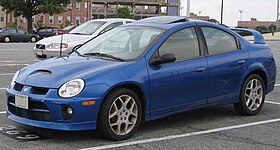Dodge SRT-4
| Dodge Neon SRT-4 | |
|---|---|
 |
|
| Overview | |
| Manufacturer | Dodge (DaimlerChrysler) |
| Production | 2003–2005 |
| Assembly | Belvidere, Illinois, United States |
| Body and chassis | |
| Class | Sport Compact |
| Body style | 4-door sedan |
| Layout | Transverse front-engine, front-wheel drive |
| Platform | Chrysler PL platform |
| Related | Dodge Neon |
| Powertrain | |
| Engine | 2.4 L EDV/EDT I4 (t/c gasoline) |
| Transmission | 5-speed NVG T-850 manual |
| Dimensions | |
| Wheelbase | 105.0 in (2,670 mm) |
| Length | 174.4 in (4,430 mm) |
| Width | 67.4 in (1,710 mm) |
| Height | 56.0 in (1,420 mm) |
| Curb weight | 2,900 lb (1,300 kg) |
| Chronology | |
| Successor | Dodge Caliber SRT-4 |
The Dodge Neon SRT-4 is a sport compact car manufactured by Dodge from 2003 to 2005. A turbocharged variant of the Neon, the car was developed by DaimlerChrysler's in house PVO (Performance Vehicle Operations) tuner group. PVO was officially renamed SRT (Street and Racing Technology) in 2004. The "4" in the SRT-4's name denotes the number of cylinders of the engine. ACR (American Club Racing) and Commemorative Edition models were later introduced as well.
In 1998, Tom Gale, (then Executive Vice President of Chrysler Product Development and Design), attended the 1998 Specialty Equipment Market Association (SEMA) Show in Las Vegas. Gale noted a list of performance features he saw on the sport compact cars at the show, and wanted to integrate those features into Chrysler’s compact production car, the Dodge Neon. Gale was the design chief of the original Dodge Viper concept vehicle, and recognized an opportunity to build a sport compact that would appeal to the younger auto generation who grew up on tuner cars, who may prefer a new car with the same performance appeal right off the showroom floor.
A group of young Dodge and Chrysler talent was assembled to put together a vehicle to meet Gale’s request, with all of the team members sharing first-hand knowledge and familiarity of the existing Dodge Neon. They created a concept car, the 2000 Neon SRT, in just 4 months, with a 2.0 L 16-valve four-cylinder topped with a 45-cubic-inch Eaton supercharger, which produced 208 hp (155 kW) and 180 lb·ft (240 N·m) of torque at the flywheel on 11 psi (0.76 bar) of boost. (Sport Compact Car magazine tested the car in the Feb. 2001 issue and dynoed 179 hp (133 kW) and 149 lb·ft (202 N·m) torque at the wheels.)
The group put more than 1000 miles on the test track with the vehicle in under two weeks. In November 1999, the car was shown at the SEMA show with a glowing response. The vehicle was then shown at the Los Angeles Auto Show in January 2000, center stage on a turntable. The team continued to work on the car, to try to bring it to the level of production vehicle, creating a second car using more production-oriented parts in an effort to lower the costs necessary to justify production. They even parked the second car in Gale’s parking spot in order to get it noticed. Regardless, in fall of 2000, the executive committee rejected the production car proposal. The team put together a list of reasons why the car was not approved, and worked through the list item by item to find solutions to every issue presented. After three more versions of the car, the company’s Specialty Vehicle Engineering (SVE) team took over the project. The executive committee once again considered the vehicle in the spring of 2001, and this time gave the go ahead for the project.
...
Wikipedia
